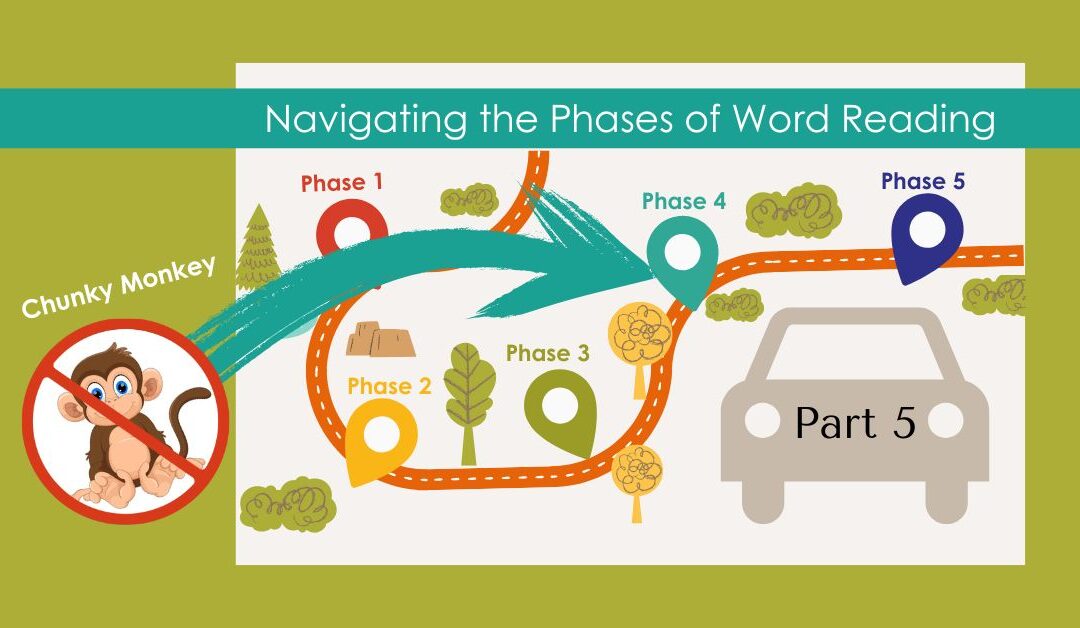This is the fifth part of our series exploring how some of the ways we’ve been prompting readers can actually send them on unnecessary detours – or even worse, down dead-end roads – when it comes to developing reading fluency. If you’ve traveled with us through this whole series, hopefully, you have a growing appreciation for how a teacher’s prompting can influence students’ future reading success. If not, we’ve linked our previous posts below.
We began this series using a map metaphor to unpack Ehri’s phases of word reading (1987, 1995, 2002, 2005, 2017). After that, and continuing through the series, we’ve used Ehri’s phases to consider the pitfalls of some favorite prompts, including those in the table below:
| Popular Mascot | Common Prompt | Phase of Word Reading the Prompt Unintentionally Encourages |
| Eagle Eye | “Look at the picture.” | Pre-Alphabetic |
| Lips the Fish | “Get your mouth ready.” | Partial Alphabetic |
| Skippy the Frog | “Skip over it.” | Partial Alphabetic |
Today, we’re thinking about when it’s the best time for students to use word chunks and when it’s better for them to focus on sound-by-sound decoding.
The Chunky Monkey character is often used as the mascot for prompting children to rely on the familiar prompt, “Look for a chunk, you know.” And while the specific directions may vary, in application, this strategy is mostly about guiding students to look for a smaller word or word part–one they already know–that is inside the “big” word. For example, a reader might look at the word stand and spot the known chunk –an-. Or they may look at the word habit and spot the familiar chunk -it.
On the surface, scouting for known word chunks seems like a common sense way to get readers to be more efficient in word-reading. We may even think that we’re thoughtfully nudging students to jump up from the full alphabetic to the consolidated phase of word reading, where readers move beyond needing to read sound-by-sound and instead start to spot familiar spelling patterns.
But when you get beneath the surface, the prompt, “Look for a chunk you know,” can actually be counterproductive for at least two very important reasons.
First of all, when we ask children to search anywhere in the word for any chunk they might recognize, we are essentially telling them, “You don’t have to process all of the print from left to right. You can jump around in the word looking for any kinds of pieces and parts you might know.”
But this isn’t how the brain reads or remembers words.
Proficient readers don’t jump all over the word looking for chunks. Instead, we process print sequentially, from left to right, starting at the beginning of the word and moving across to the end. Prompting children to move their eyes all over the word encourages inefficient habits for how to analyze words.
“But, wait!” You might be thinking. “When I encounter a new word – like tergiversation – I definitely tackle it chunk-by-chunk!”
And you do.
As an experienced reader working your way across a new word, you quickly spot familiar letter strings, or “chunks,” along the way. These are those little words or words part that you can read without having to blend every sound. It might sound something like, “ter-giv-er-sa-tion”.
But the only reason you can do this is because you have read each of those syllables sound-by-sound enough times to remember them and read them automatically. This consolidated phase of readily spotting familiar patterns cannot be rushed or forced.
So, when do readers enter the consolidated phase of word reading?
As experienced readers, we didn’t enter the consolidated phase of word-reading because someone told us it was time to try to “find some chunks we might know.” Our brains began consolidating chunks because they had processed the common patterns of SOOOOO much print that we started noticing that certain series of letters often occur together and in a specific order. Our brains started to recognize more and more familiar chunks instantly and automatically.
Yet even though experienced readers do work with chunks, we don’t jump all over the word hoping to see something we might recognize. Instead, we carefully work across an unfamiliar word from left-to-right, using the efficiency of chunks in a linear way. And when we go back and reread a second time, those known chunks can help us blend the many parts into one whole word more smoothly.
The reality is that readers need to build strong skills for sound-by-sound decoding before they are ready to use consolidated chunks efficiently. Trying to prematurely propel children into the consolidated phase of word reading may be a bit like pushing beginning drivers from learning permit to driver’s license before they have enough behind-the-wheel hours.
If they were ready for it, their brains would already be doing that! But children aren’t ready for the consolidating phase until their brains are, well, consolidating.
The second problem with pushing children to consolidate before they are ready is, without enough time spent on decoding and mapping print, readers won’t recognize the way a lot of the “little words,” or chunks, operate differently inside “big words” than they do when they are on their own.
For example, look at the list below and think about the helpfulness (or unhelpfulness) of spotting the little word “it” in each of these words.
sit
pitch
white
fruit
vital
hospital
As you can see, the consolidated phase of word reading requires a lot more of the brain than simply spotting little words or word chunks within words.
So, ironically, nudging children out of full-alphabetic work prematurely means that they miss opportunities for work (within the full alphabetic phase) that will eventually set them up to actually consolidate in earnest. Unfortunately, our eagerness to move them toward chunking parts of words before they are developmentally equipped prompts them to bypass the essential work that helps them do the very thing we are asking of them.
So, since Chunky Monkey sends inexperienced readers bouncing around the word in a non-linear fashion, trying to do work of the consolidated phase before they are ready, it is yet another character we should retire.
But don’t get discouraged. In our final post of this series, we’ll share a couple of prompting mascots that seem to keep beginning readers on the right path, doing the effortful yet essential work of the full-alphabetic phase while also preparing them to move solidly into the consolidated and automatic phases.
Until next time, take good care of yourself!
❤️ Jan and Kari
P.S. Wondering what to teach instead of looking for chunks?
It’s not anything fancy or clever!
It’s simply using a prompt that directs children to the print, drawing on all they know about sound-spellings. Here are some of our favorites:
“Sound it out.”
“Look all the way across the word. Make the sounds.”
“Keep your eyes on the word. Put the sounds together.”
Then, only after students have used all of the print–sound-by-sound from left-to-right–to come up with what they think is the word, do we follow up with prompts like, “Did that make sense?” or “Does that sound right?” This keeps decoding as the strategy of first resort, and context and meaning as ways to confirm decoding attempts.
If you want to learn more about this important topic, it is the primary focus of Shift 5 in our book – Shifting the Balance: 6 Ways to Bring the Science of Reading into the Balanced Literacy Classroom – and in our online class.
References
Ehri, Linnea C. 1995. “Phases of Development in Learning to Read Words by Sight.” Journal of Research in Reading Research 18 (2): 116-125.
Explore the whole blog series:
Showing Young Readers How to Navigate the Phases of Word Reading
Part 1: A Journey Through Ehri’s Phases
Part 2: Why Looking at the Pictures Isn’t as Helpful as We Thought
Part 3: Why Looking at the First Letter of the Word Isn’t Enough
Part 4: Problems With Skipping Words
Part 5: The Downsides of Asking Children to Search for Chunks in Words
Part 6: The Power of Teaching Students to Blend Words
BONUS: The Power of Teaching Readers to Try Alternate Sounds



Recent Comments